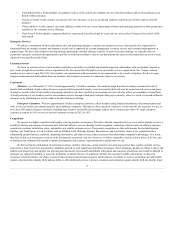LifeLock 2013 Annual Report Download - page 21
Download and view the complete annual report
Please find page 21 of the 2013 LifeLock annual report below. You can navigate through the pages in the report by either clicking on the pages listed below, or by using the keyword search tool below to find specific information within the annual report.
effectiveness of our internal controls or concludes that we have a material weakness in our internal controls), we could lose investor confidence in the accuracy
and completeness of our financial reports, which could have a material adverse effect on our reputation and the price of our common stock.
We no longer qualify as an “emerging growth company.” As an “emerging growth company,” we were previously able to take advantage of certain
exemptions from various reporting requirements that are applicable to other public companies that are not emerging growth companies, including not being
required to comply with the auditor attestation requirements of Section 404 of the Sarbanes-Oxley Act, reduced disclosure obligations regarding executive
compensation in our periodic reports and proxy statements, and exemptions from the requirements of holding a nonbinding advisory vote on executive
compensation and stockholder approval of any golden parachute payments not previously approved. As a result of no longer qualifying as an “emerging
growth company,” we are subject to increased disclosure and governance requirements, including the foregoing, which will subject us to additional legal,
accounting, and other expenses.
We have experienced rapid growth in a relatively short period of time. Our revenue grew from $18.9 million in 2007 to $369.7 million in 2013, and our
members increased from approximately 30,000 on December 31, 2006 to approximately 3.0 million on December 31, 2013. In addition, our acquisitions of ID
Analytics in March 2012 and Lemon in December 2013 increased our revenue, facilities, and number of employees, and we will likely hire additional
employees in the future. We must successfully manage our growth to achieve our objectives. Our ability to effectively manage any significant growth of our
business will depend on a number of factors, including our ability to do the following:
•introduce new service offerings that are attractive to our customers and enhance our gross margins;
•develop and pursue cost-effective marketing and advertising campaigns that attract new customers;
•satisfy existing and attract new customers;
•hire, train, retain, and motivate additional employees;
•enhance our operational, financial, and management systems;
•enhance our intellectual property rights;
•effectively manage and maintain our corporate culture; and
•make sound business decisions in light of the scrutiny associated with operating as a public company.
These enhancements and improvements will require significant expenditures and allocation of valuable management and employee resources, and our
growth will continue to place a strain on our operational, financial, and management infrastructure. Our future fin ancial performance and our ability to execute
on our business plan will depend, in part, on our ability to effectively manage any future growth. There are no guarantees we will be able to do so in an
efficient or timely manner, or at all. Our failure to effectively manage growth could have a material adverse effect on our business, reputation, operating
results, financial condition, and prospects.
From time to time, we may review opportunities to acquire other businesses or other assets that would expand the breadth of services that we offer,
strengthen our distribution channels, enhance our intellectual property and technological know-how, augment the LifeLock ecosystem and our data
repositories, or otherwise offer potential growth opportunities. For example, in March 2012, we completed our acquisition of ID Analytics, and in December
2013, we completed our acquisition of Lemon. We may in the future be unable to identify suitable acquisition candidates or to complete the acquisition of
candidates that we identify. Increased competition for acquisition candidates or increased asking prices by acquisition candidates may increase purchase
prices for acquisitions to levels beyond our financial capability or to levels that would not result in the returns required by our acquisition criteria.
Acquisitions also may become more difficult in the future as we or others, including our competitors, acquire the most attractive candidates. Unforeseen
expenses, difficulties, and delays that we may encounter in connection with rapid expansion through acquisitions could inhibit our growth and negatively
impact our operating results.
Our ability to grow through acquisitions will depend upon various factors, including the following:
•the availability of suitable acquisition candidates at attractive purchase prices;
•the ability to compete effectively for available acquisition opportunities;
•the availability of cash resources, borrowing capacity, or stock at favorable price levels to provide required purchase prices in acquisitions;
18
























